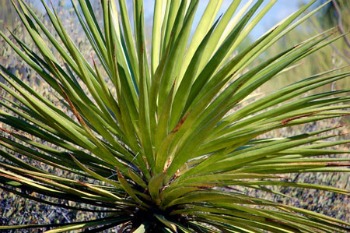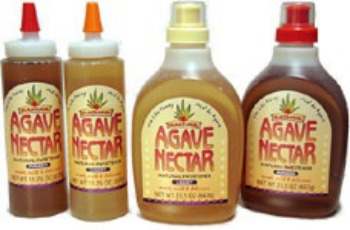Agave (pronounced ah-GAH-vay) nectar is a syrup made from the agave plant. It has become popular in recent years as people look for healthier alternatives to white sugar. Called agave, agave syrup or agave nectar, this liquid sweetener is similar to honey but has a thinner consistency and a slightly more intense flavor. Agave nectar has a low glycemic load so it won’t elevate blood sugar levels as quickly as white sugar – a definite benefit for diabetics.
Often touted as a health food, the use of agave nectar as a healthy sugar replacement is not without its critics. Although labeled “natural”, some claim this label is misleading as agave nectar has to be processed in order to concentrate its sweetness. It is refined fructose, a type of sugar which in large quantities has been linked to some health risks.
History of Agave Nectar:
Agave nectar comes from the agave plant of which there are over 100 different species. It grows in the volcanic soils of Mexico where it has been used by natives of Mexico for many centuries. Aztecs prized the agave plant and believed it was a gift from the gods. Both the flowers and nectar of the agave plant are edible and for the Aztecs it was an important food source, harvested after winter and eaten as a vegetable. Agave nectar is used to make an unfermented drink called Aguamiel (which translates to honey water) and fermented for Mescal and Tequila.
How is the Agave Nectar harvested?

Commercial sweetener made from agave nectar was developed in the 1990s in Mexico. All commercially available agave nectar comes from. Mexico – it is currently the only country producing it.
When the agave plant is 7 to 10 years old, the nectar is harvested from live plant. This process is similar to how maple trees are tapped. The top is cut off, and the core, called the pina, is hollowed out . The cap is then replaced and nectar is allowed to gather in the center for several days. The liquid is then removed for processing.
Agave nectar is processed in one of two ways:
The first involves adding enzymes to the liquid to split the complex natural sugars into the simple sugars fructose and glucose. This is similar to how bees make honey from nectar.
The second process, hydrolysis, is generally considered to produce superior results.
Agave nectar is either regular or raw. The nectar is boiled down to concentrate its sweetness. To be considered raw, it is not been heated beyond 118 to 120. This way, raw agave nectar is still filled with living enzymes.
Agave syrup comes in a variety of shades from light to amber and dark in color. The light colored nectar is also the lightest in flavor – it is flavor neutral. It imparts sweetness but no flavor of its own. The amber and dark varieties impart a mellow flavor similar to that of honey or maple syrup. The darker the agave syrup, the more nutrients, minerals and flavor of the plant remain.
Benefits of Agave Nectar:
Agave has become very popular as an alternative sweetener mainly because it does not cause a huge spike in blood sugar as do other sweeteners such as white sugar. The fructose in agave is slow release. This is good news for diabetics. Agave’s glycemic index (GI). is low. It ranges from 28 to 32 – whereas honey’s is 58.
Other reasons to try agave nectar:
Rich in vitamins E, C, D, and E.Rich in calcium, iron, zinc and magnesium. Almost all agave’s are organically grownHas a long shelf life. Agave nectar is easy to pour and due to its thin consistency, dissolves blends well with other ingredients.
Too Good to be True?
Not everyone is a fan of agave nectar. Due to great marketing, agave nectar has become known as “good for you”. It is seen as a whole, natural, health food. This advertising may be misleading. The liquid from agave is processed to extract the nectar and the process may remove many of the beneficial minerals that are natural to the agave plant.
Agave nectar is essentially refined fructose. The fructose found in whole foods is rarely a problem, however, this chemically extracted variety may be a damaging form of sugar especially if consumed in large quantities. Fructose causes insulin resistance and raises levels of triglycerides. When consumed in heavy doses, it interferes with healthy metabolism.
The contradicting information surrounding agave nectar can be confusing. On the one hand, it has a low-glycemic index and high-quality agave nectar is rich in vitamins, minerals and nutrients.
But does this mean it is good for you? Used in moderation, agave nectar is unlikely to be harmful. However, it is important not to be fooled into thinking that it is a healthy, “free food” to be indulged at will! We need to remain conscious of what we put into our bodies, to understand what agave is and use it accordingly – not all the time and not in huge amounts. Personally, I believe agave nectar is worth trying. As a sweetener it rates well for some of the benefits discussed above, is a good alternative to white sugar and adds variety to our diets.
Some Common Uses for Agave Nectar:
Beverages:
Agave nectar dissolves easily, making it is a good sweetener for drinks such as iced tea.
Sweetening:
It can be used to sweeten food anywhere you would use honey – drizzled over yogurt, porridge or cereal.
Salad Dressings and Sauces:
It’s also great for salad dressings and other kinds of sauces.
Baking:
Agave nectar can be used in baking. Generally it is recommended to use three quarters (3/4) the amount of agave for the amount of sugar called for in the recipe and to reduce the liquid. When baking, the moisture retention of agave syrup is similar to honey and can be substituted in the same amount for both honey or maple syrup. This makes it good for cakes and breads. However may not be the best choice for crisp cookies or hard candy. Agave syrup can cause baked goods to brown more quickly so you may need to reduce the oven temperature by 25 degrees F.
How To Substitute Agave Nectar for other Sweeteners:
Honey – 1 cup of honey = 1 cup of agave nectar
Maple syrup – 1 cup of maple syrup = 1 cup of agave nectar
Brown rice syrup – 1 cup brown rice syrup = 1/2 to 1/3 cup agave nectar and increase other liquids in the recipe by up to1/2 cup
Corn Syrup – Use 1/2 as much agave, and increase other liquids in the recipe by up to 1/3 of a cup
Granulated/white sugar- 1 cup of white sugar = 2/3 cup agave nectar and reduce other liquids in the recipe by 1/4 to 1/3 cup
Brown sugar – 1 cup of brown sugar = 2/3 cup agave nectar and reduce other liquids in the recipe by 1/4 cup (Brown sugar has a higher moisture content than white sugar; liquids need not be reduced as much.)
 Charlotte Bradley is the publisher of YogaFlavoredLife.com and an avid yoga practitioner. She was a student of karate for many years and took up yoga only tentatively after the birth of her sons and a knee injury left her looking for a less high-impact form of exercise. It was love at first pose as Charlotte saw how quickly yoga sped her rehabilitation along. She also found that yogic relaxation techniques lent her proper focus, bringing balance into her life as well as a greater appreciation for how blessed she truly is. She lives in Ottawa, Ontario with her husband and twin boys, Charlie and Patty, who keep her on her feet and on the go. Her golden retriever supervises Charlotte’s yoga workouts from a spare mat, with his eyes closed.
Charlotte Bradley is the publisher of YogaFlavoredLife.com and an avid yoga practitioner. She was a student of karate for many years and took up yoga only tentatively after the birth of her sons and a knee injury left her looking for a less high-impact form of exercise. It was love at first pose as Charlotte saw how quickly yoga sped her rehabilitation along. She also found that yogic relaxation techniques lent her proper focus, bringing balance into her life as well as a greater appreciation for how blessed she truly is. She lives in Ottawa, Ontario with her husband and twin boys, Charlie and Patty, who keep her on her feet and on the go. Her golden retriever supervises Charlotte’s yoga workouts from a spare mat, with his eyes closed.
Categories:
Cooking Lessons - Cooking 101 Healthy Lifestyle Sugar Hints & Tips Sugar History Sugar Substitutes Hints & Tips

2 Responses to “Agave Nectar”
Greg Blair
Hi Charlotte,
I agree with your point that used in moderation Agave nectar is unlikely to be harmful. There’s an interesting complementary article here showing nutrition properties graphically of agave vs other sweeteners
Margo Haynes
Thank you so very much regarding the low glycemic level…I have diabetes 2 … I just found your site today & have just subscribed to your newsletter. I truly enjoy going through your site & all of the information that I’ve found here. Thank you for all of the hard work, research and love that you pour into this site.
Have a blessed day!
Margo